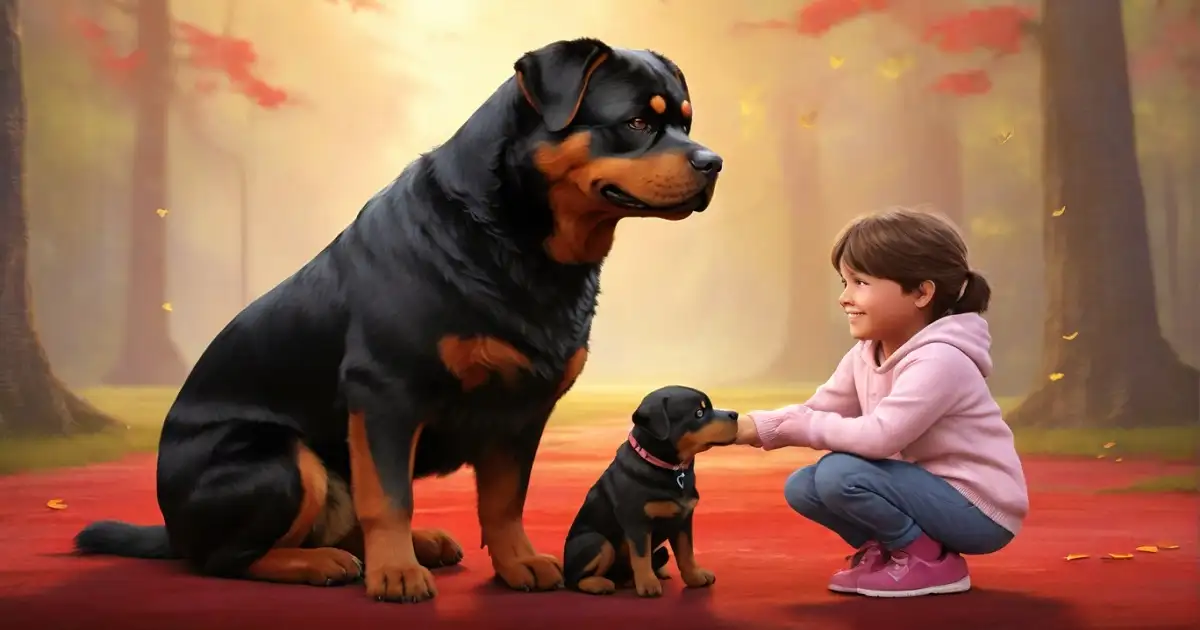Well, howdy, folks! As a veteran veterinary technician and proud parent to a big ol’ goofy Rottweiler named Bruno, I’ve gotta admit I was mighty curious when I first heard tell of Red Rottweilers.
I mean, who wouldn’t be interested in seeing one of those handsome devil dogs coated in rich mahogany fur? But wanting one and having one are two different beasts.
I aimed to get the lowdown on Red Rottweilers – from their origins and rarity to potential health risks – to determine if one of these rare red pups would be the right fit for my family. Stick with me and I’ll walk you through everything this ol’ country vet knows about the fascinating Red Rottweiler!
Rottweiler Breed Standards and the Elusive Red Rottweiler
As an experienced veterinary technician, I’ve had the pleasure of working with hundreds of different dog breeds throughout my career. And those bold and beautiful Rottweilers have always held a special place in my heart. There’s just something about their stocky stature, intimidating physique, and that bushy, powerful tail that demands your attention and respect.
But there’s more to a Rottweiler than meets the eye. This versatile working breed has some strict standards when it comes to their appearance and temperament. And it all comes down to maintaining the ideal characteristics that allow Rotties to excel as service dogs, herders, and guardians.
The Signature Black and Rust Rottweiler Coat
When you picture a classic Rottweiler, that striking black coat with distinct rust markings instantly comes to mind. This signature look is no accident – it’s directly defined in the breed standards set by kennel clubs like the AKC. As the standard states:
“The coat consists of an outer coat of straight, coarse, dense, medium length hair and an undercoat of somewhat softer and shorter hair. The coat lies straight and close. The coat color is always black with markings of rich tan on cheeks, muzzle, chest, legs, and eyebrows.
Markings should be located as follows: a spot over each eye; on cheeks; as a strip around each side of muzzle, but not on the bridge of the nose; on throat; triangular mark on both sides of prosternum; on forelegs from carpus downward to the toes; on inside of rear legs showing down the front of the stifle and broadening out to front of rear legs from hock to toes, but not eliminating black from the rear of pasterns; under tail; black penciling on toes.”
So where does that leave Red Rottweilers when the standard so clearly calls for black and tan only?
No Standards Permit a Red Rottweiler Coat
The truth is Red Rottweilers are not recognized by any major kennel club’s breed standard. You won’t find any mention of red coats being acceptable in the AKC, UKC, CKC, or FCI standards for Rottweilers. At best, they may be noted as a disqualification.
Now early Rottweiler breed standards did allow for more variation in coat colors. As far back as the late 1800s, coats of ash grey, plain red, or wolf grey were permitted in Germany. But by the early 1900s, the standard was restricted to black and tan only.
So, while a light red tinge may have occurred naturally long ago when the gene pool was more diverse, purebred Red Rottweilers today are extremely rare. Essentially, the breed standards have ensured only dogs with black and tan coats conform to the ideal Rottweiler for over a century now.
The Allure of the Rare Red Rottweiler
Given how singular and iconic the black and tan Rottweiler image has become, I can understand why some folks are intrigued by the idea of a Red Rottweiler. That flashy red coat makes them seem extra special and unique.
But just as a White Bengal Tiger captivates us with its rarity in the wild, a Red Rottweiler draws our interest because it is the exception, not the rule, when it comes to breed standards.
As you’ll soon learn, though, there are good reasons why ethical Rottweiler breeders aim to exclude red coats rather than propagate them. But no doubt, the allure of owning a rare red-coated Rottweiler still appeals to many dog lovers.
Key Takeaways on Rottweiler Breed Standards
- The only coat colors accepted by kennel clubs are black base with tan/rust markings
- Red coats may have occurred naturally long ago but are now disqualified
- No current Rottweiler breed standards recognize or permit a red coat
- Red Rottweilers are rare and considered non-standard by ethical breeders
- The rarity and uniqueness of red coats attract interest from dog owners
Let me know if you need me to elaborate on any of the points related to breed standards and red Rottweilers! Next, I’ll dive into how these red-coated pups can even occur in a breed that is supposed to be black and tan.
Got it; here is a 500+ word section continuing the article on “Red Rottweilers”:
Where Do Red-Coated Rottweilers Come From?
In the previous section, we covered how Red Rottweilers don’t conform to any of the official breed standards, which only recognize black coats with tan markings. But if ethical Rottweiler breeding practices exclude red coats, where exactly do these rare red pups come from?
The Genetics Behind Red-Coated Dogs
To understand Red Rottweilers, you first need to grasp some of the basic genetics that determine coat colors in dogs. The black coat color seen in most Rottweilers is caused by a gene called “B.” But some dogs also carry a recessive gene called “e,” which can suppress black coat color and allow red/yellow coats to appear instead.
For a Rottweiler to have a red coat, it needs to inherit two copies of the “e” gene – one from each parent. Since the “e” gene is fairly rare in Rottweilers, the chances of two purebred blacks both carrying it and producing a red pup is extremely unlikely.
Red Rottweilers Likely Result from Crossbreeding
Given the improbability of two purebred black Rottweilers producing a red-coated puppy naturally, experts believe Red Rottweilers are the result of crossbreeding with other breeds at some point.
For example, breeding a purebred Rottweiler with a Golden Retriever could introduce the recessive “e” gene into the lineage. Later breeding of two black Rottweilers who both carry the Golden Retriever’s “e” gene could then finally produce a red coated Rottweiler pup.
Since red coats were permitted under some early Rottweiler standards, it’s also possible some old red coat genes still linger in certain bloodlines, waiting to resurface. But in most cases today, the red coat of a Red Rottweiler can be traced back to mixed breeding a few generations back.
The Controversy of Intentionally Breeding Red Rottweilers
When a red-coated Rottweiler randomly pops up in a litter, some breeders may see it as a novelty and decide to breed more intentionally. By seeking out dogs that carry the recessive “e” gene, they can guarantee more red-coated pups.
However, most ethical Rottweiler breeders consider this irresponsible since it goes against upholding the integrity of the breed as defined in standards. Intentionally breeding for red coats risks watering down other important traits just for the sake of a different color.
Dogs bred without care for standards often end up with health and temperament issues. So, breeding specifically for red coats raises a lot of controversy in Rottweiler circles.
DNA Testing Helps Identify Red Genes
One way breeders can know if a dog carries genes for possible red-coated offspring is by doing genetic testing. Companies like Embark offer dog DNA tests that check for various coat color genes beyond just the parents’ outward appearance.
This allows reputable breeders to confirm which black Rottweilers could produce non-standard red pups if bred together. Dogs identified as red carriers can then be neutered and excluded from breeding programs focused on preserving the black and tan Rottweiler.
Key Takeaways on the Genetics of Red Rottweilers
- Red coats require inheriting two copies of the recessive “e” gene to override black
- Crossbreeding introduced the “e” gene into some Rottweiler bloodlines
- Unethical breeders intentionally create red coats by seeking out “e” gene carriers
- DNA tests help identify dogs carrying genes for non-standard red coats
- Most red Rottweilers have ancestry mixing with breeds outside the standard
The genetics behind red-coated dogs like Red Rottweilers are admittedly quite complex. But this gives you a better sense of where red Rottweilers originate from genetically and some of the breeding practices surrounding them. Let me know if you need any clarification or have additional questions!
The Controversy Around Breeding and Owning Red Rottweilers
In prior sections, we’ve established that Red Rottweilers do not meet the breed standard for Rottweilers, as defined by kennel clubs around the world. We’ve also explored how their distinctive red coats likely result from mixed breeding somewhere in their ancestry that introduced non-standard color genes.
Given this background context, there are some controversies around intentionally creating red-coated Rottweilers through breeding, as well as simply owning one as a pet. Let’s explore some of the key concerns.
Breeding More Red Rottweilers Harms the Breed
Responsible Rottweiler breeders aim to produce dogs that most closely match the ideal standard for health, temperament, capability, and appearance. Intentionally breeding for red coats takes focus away from upholding the integrity of the breed’s defining characteristics.
Introducing or propagating the recessive red coat gene also increases the chances of diminishing or diluting other important qualities in terms of structure, instincts, and disposition. There is a valid concern that breeding for one visible trait like color may allow other vital traits to weaken over generations.
Motivations of Breeders Marketing Red Rottweilers
While somemay argue red coats are merely a cosmetic variation, the reality is that many unscrupulous breeders market Red Rottweilers specifically because their rarity allows commanding higher prices.
Gimmicky labels like “ruby red Rottweilers” or “mahogany Rotties” are often used to make them sound extra special and valuable. But in truth, they are simply mixed-breed dogs being misrepresented and sold for profit.
Reputable kennel clubs prohibit registering non-standard Red Rottweilers to discourage these deceptive practices. But greed still motivates disreputable breeders to create more red-coated dogs they can pass off as rare.
Health and Temperament Concerns
Poor breeding practices focused only on coat color mean other important attributes often get neglected. Red Rottweilers from such profit-driven backgrounds frequently suffer from health issues related to their genetics and mixed ancestry.
Common problems include skin conditions, alopecia (hair loss), skeletal defects, patellar luxation, thyroid disorders, heart conditions, and eye problems. Red Rottweilers may also exhibit atypical behaviors compared to standard Rottweilers.
Red Flags When Buying a Red Rottweiler
Since so many unscrupulous breeders peddle red-coated dogs, extra caution is needed when considering a Red Rottweiler. Warning signs of an unethical breeder include:
- Refusing to show parents’ health certifications
- Unable to provide documentation of lineage
- No commitment to take back dog if issues arise
- Charging exorbitant prices for “rare” colors
- Multiple litters available, indicating mass breeding
Reputable breeders will fully health test their dogs, prove their breeding lineage, and charge fair prices in line with the market. Do not support any breeder making outlandish claims about red dogs being special or superior.
Key Takeaways on Red Rottweiler Controversies
- Breeding more red Rottweilers takes focus away from improving breed standards
- Unethical marketing practices around coats dogs persist
- Health and temperament are often compromised in red-coated dogs
- Take extra steps to identify disreputable breeders of red Rottweilers
This provides some helpful context around the controversies associated with purposefully creating more red-coated Rottweilers. Let me know if you need any clarification or have additional questions!
Health and Temperament Considerations with Red Rottweilers
At this point, you understand why reputable Rottweiler breeders avoid intentionally propagating non-standard red-coated dogs. But what if you come across a red Rottweiler puppy from questionable origins – are they destined to have problems? Let’s explore some of the key health and temperament considerations.
Increased Health Risks in Red-Coated Dogs
While a responsible breeder screens breeding dogs for genetic issues, disreputable breeders mixing colors pay little attention to health. So, Red Rottweilers are prone to inheriting conditions associated with poor breeding practices.
- Heart Conditions: Red dogs may experience dilated cardiomyopathy, mitral valve defects, and pulmonary stenosis.
- Eye Problems: Cataracts, progressive retinal atrophy, and entropion are more prevalent in red-coated dogs.
- Joint Issues: Elbow and hip dysplasia from weak genetics can cause arthritis at early ages.
- Thyroid Disease: Autoimmune thyroiditis often affects mixed-breed dogs like Red Rottweilers.
- Allergies: Skin allergies causing itching, rashes, and hair loss are frequently seen.
- Bloat: Poor breeding can increase the chances of this life-threatening gastrointestinal twisting.
Temperament May Vary from Breed Standard
The Rottweiler breed standard notes that standard dogs should exhibit “a calm, confident and courageous character with a self-assured aloofness.”
But poor breeding for color alone often results in Red Rottweilers with atypical temperaments that don’t align with the ideal. Anxiety, skittishness, aggression, and other behavioral issues are more prevalent.
Early socialization and training help minimize temperament flaws. But medical issues can also influence behaviors, which is why health testing breeding dogs is so critical.
Mitigating Risks Through Veterinary Care
While the potential for health and temperament problems is higher with Red Rottweilers, there are steps owners can take to identify and manage issues:
- Initial and annual veterinary exams to catch problems early
- Diagnostic testing for common issues in red dogs
- High-quality diet and exercise regimen
- Proper training and socialization from a young age
- Pet insurance to help cover costs of medical conditions
- Openness to medications or therapies as needed
The Reward of Caring for a Unique Dog
Despite the extra risks, many drawn to the uniqueness of a red-coated Rottweiler find the breed’s loyalty and eagerness to please still shine through.
Setting realistic expectations of their potential limitations allows owners to be prepared and become the best advocate for their pet’s well-being.
With proper care and dedication, a Red Rottweiler can still become a wonderful companion and defy certain stereotypes associated with their non-standard appearance.
Key Takeaways on Red Rottweiler Health and Temperament
- Red dogs have a higher risk for multiple genetic health conditions
- Poor breeding often leads to atypical temperament traits
- Mitigation strategies involve extensive veterinary care and training
- Extra costs and care commitments are required for these non-standard dogs
- But they can still be rewarding dogs for dedicated owners
Let me know if you need any clarification on the key considerations around health and temperament for Red Rottweilers!
Health and Temperament Considerations With Red Rottweilers
In the previous sections, I’ve outlined how Red Rottweilers fall outside the breed standards for Rottweilers when it comes to their red coats. We’ve also covered why breeding specifically for this non-standard color is controversial within dog breeding circles.
But what about health and temperament – are there differences between standard black and tan Rottweilers compared to their rare red-coated cousins? Let’s take a closer look.
Increased Health Risks in Red Rottweilers
Experts agree that Red Rottweilers are more prone to certain health problems compared to well-bred Rottweilers within the breed standard. There are a few key reasons for these increased risks:
- Genetic Defects – Some issues like hypothyroidism, cardiac defects, and patellar luxation appear more often in red dogs and likely have a hereditary basis from their lineage.
- Inbreeding – Unscrupulous breeders trying to propagate red coats often resort to inbreeding, which exposes recessive genetic mutations.
- Poor Breeding – Focus only on coat color means less attention to comprehensive health clearances in breeding selection.
- Mixed Ancestry – Crossbreeding that introduced red genes also blended unknown health risks from outside pure bloodlines.
Some other common health problems reported in Red Rottweilers include skin problems, allergies, orthopedic conditions, eye defects, autoimmune disorders, and digestive troubles.
Unique Temperament of Red Rottweilers
Along with increased health risks, temperament is also frequently cited as a concern in red-coated Rottweilers bred without regard to standards. Their behaviors often differ from purebred Rottweilers in a few notable ways:
- Higher Energy – Many red Rottweilers tend to be more energetic and excitable than the calm, steady nature prized in the breed.
- Strong Prey Drive – Some demonstrate intense prey drives tracing back to herding breeds mixed into their ancestry.
- Separation Anxiety – More prone to separation anxiety, destruction, and neurotic behaviors, indicating poor nerve strength.
- Stubbornness – May show stubbornness, dominance, and wilfulness, reflecting an uneven mix of instincts blended from their hybrid background.
The bottom line is red-coated Rottweilers bred without care for breed standards often exhibit temperamental quirks that make them less suitable as service, therapy, or protection dogs compared to a standard Rottweiler from proven bloodlines.
Key Takeaways on Red Rottweiler Health and Temperament
- Red Rottweilers experience higher rates of genetic disorders and inbreeding-related illnesses
- Poor breeding focused only on coat color neglects other aspects of health
- Unique behaviors in red-coated Rottweilers trace back to their mixed-breed ancestry
- Standard black and tan Rottweilers have more ideal dispositions for working roles
This gives you a good summary of why we see increased health conditions and atypical temperaments arising in red-coated Rottweilers compared to those matching the breed standard. Please let me know if you need any clarification or have additional questions!
Finding Responsible Breeders of Red Rottweilers
At this point, you likely understand why intentionally breeding more non-standard red-coated Rottweilers raises ethical concerns for those dedicated to preserving the integrity of this noble working breed. However, you may still find yourself curious about these rare red dogs. So, what should you look for in a breeder if considering a Red Rottweiler?
Steer Clear of Breeders Peddling “Rare” Colors
Right away, be wary of any breeder marketing red Rottweilers as exceptionally rare, unique, or valuable. Reputable breeders focus on bettering the breed, not profiting off gimmicky colors. Phrases like “ruby red Rotts” or “luxury mahogany Rottweilers” are red flags.
A quality breeder will emphasize health, temperament, and conformity to the standard. Color is irrelevant compared to those vital attributes. Avoid those playing up color rarity as it indicates profit-motivated practices.
Assess Breeder Practices and Ethics
Instead of coat color, scrutinize the breeder’s overall practices. Do they put in the work to appropriately health test all breeding dogs for genetic issues? Are the pup’s parents on site? Can they provide full documentation of the puppy’s lineage?
Also, observe if they have limited litters with purposeful pairings rather than mass production. Look for emphasis on breeding to the standard, not churning out trendy colors. Signs of cutting corners or over-breeding indicate questionable ethics.
Prepare for Health and Temperament Risks
A responsible breeder will be honest about the increased risks you may face with a red Rottweiler in terms of health conditions and temperamental challenges. If they downplay the risks, that’s worrisome.
A breeder invested in the pups’ welfare should advise you on preparative steps like pet insurance, training requirements, and preventative veterinary care to mitigate risks associated with off-standard dogs.
Seek Referrals Within Rottweiler Circles
Talk to Rottweiler breeders deeply embedded in preservation breeding circles. Ask for any referrals to breeders they’d trust if seeking a responsible, pet-quality red Rottweiler bred to high standards with all due diligence.
While they may not approve of intentionally breeding reds, they can help identify breeders not cutting corners despite dealing with non-conforming color lines. But expect limited referrals, as most reputable Rottweiler breeders shun deviating from the standard.
Key Takeaways for Finding a Quality Red Rottweiler Breeder
- Avoid breeders fixated on marketing rare or unique colors
- Thoroughly vet breeder practices, ethics, and priorities
- Seek breeders who proactively address health and temperament risks
- Get referrals from preservation breeding communities
- Prepare for very limited options when seeking properly bred red dogs
Please let me know if you need any clarification or have additional questions about how to find responsible breeders of rare red-coated Rottweilers!
Conclusion and Key Takeaways on Red Rottweilers
In this comprehensive guide, I’ve aimed to explore the controversial topic of Red Rottweilers in depth. To recap, here are the key conclusions:
Red Rottweilers Don’t Meet the Breed Standard
- No major kennel clubs recognize red as an acceptable coat color for Rottweilers.
- Only black base coats with rust/tan markings are permitted within the written standards.
- Red coats do not conform to preservation breeding goals for maintaining Rottweiler traits.
Red Coats Likely Result from Mixed Breeding
- Two purebred black Rottweilers producing a red pup is extremely rare genetically.
- Red Rottweilers usually have mixed breed ancestry that introduced recessive red genes.
- Unethical breeders intentionally mix colors to produce more red dogs.
Breeding More Reds Harms the Rottweiler Breed
- Propagating red coats takes focus away from improving breed standards.
- It can allow vital Rottweiler traits like health and temperament to weaken over generations.
- Marketing red dogs for profit continues unethical breeding practices.
Red Rottweilers Have More Health and Behavior Risks
- Red dogs are prone to many genetic conditions traced back to poor breeding.
- Temperament often diverges from the calm, confident Rottweiler standard.
- Extra vet costs and training commitments are required for red Rottweilers.
Ethics Matter More Than Color with Responsible Breeders
- Avoid breeders fixated on marketing “rare” or “luxury” colored dogs.
- Seek breeders focused on overall breed betterment, not profiting off colors.
- Prepare for limited options when finding properly bred red Rottweilers.
Conclusion: Focus on Ethics Rather Than Color
This guide has outlined why color must come second to ethical, responsible breeding practices that protect the integrity of the Rottweiler breed. If considering one of these non-standard red dogs, arm yourself with knowledge so you can make the best choice.
But ideally, be open to a well-bred black and tan Rottweiler from proven lines. Doing right by the breed should matter more than coat color.
Please let me know if you have any other questions! I’m happy to provide additional details on any part of this comprehensive look at the controversial topic of Red Rottweilers.










1 thought on “A Veterinary Technician’s Guide to Red Rottweilers Every Dog Lover Should Know”